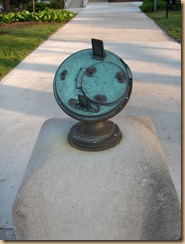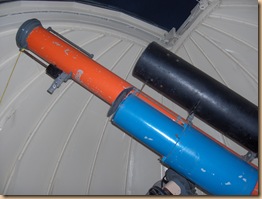Saturday evening I went with my women’s group to the Hume Cronyn Memorial Observatory at the University of Western Ontario. (side note: Actor Hume Cronyn of Cocoon, Batteries Not Included and many other movies was born here in London, Ontario).
Every Saturday night from 830 pm until about 11, some of the professors from the astronomy department at the university open up the observatory and allow the general public in to learn more about astronomy and to have a look through the telescope.
One of the professors opened up with a short slideshow/lecture to tide us over until the sun went down. It was fascinating stuff (although some of it went over our heads!) about the search for new planets and ultimately, the search for planets that may/may have supported life.
He explained the procedure astronomers use for finding and mapping these planets and then for determining their potential for life. I won’t go into it here as it’s quite involved but I have to say it was really really interesting.
(PS- anyone know what kind of tree this is? It’s really unique looking!)
Then we were taken upstairs to the telescope. We were concerned because there was a lot of cloud cover that night and at first, we were all thinking we wouldn’t be able to see anything.
Within a short time, the clouds cleared, though, and we were able to look through the big telescope or through a smaller one out on the balcony. The first thing we observed was the Moon.
Flickr, Slideshow Bruce
We’ve all seen the Moon, likely thousands of times over the course of our lives, and I suppose it could be easy to take it for granted.
Flickr, Richardefreeman
But when you can look at and see the craters in such detail as you see above, it’s absolutely inspirational. It was difficult to give up the telescope and let someone else have a turn because the images we saw were so compelling.
Flickr, andrusdevelopment
Then, the telescope was turned and aimed at Saturn. If looking at the craters on the moon in detail was inspirational, seeing Saturn and its rings felt positively magical. We were all positively giddy looking at it! It’s funny because every time someone would see it, they would come up to our group and comment on how “fake” it looked. We all thought it looked like someone had painted a silhouette of Saturn onto the end of the telescope! But really, I think it was just that our brains couldn’t truly comprehend that we were viewing something that we had only previously seen images of in books.
Flickr, c_a_palmer; Saturn was overexposed in this photo to reveal its moons. On the left, very close to the planet is Tethys, on the right very close to the planet is Dione, then Rhea, and then the furthest one out to the right and the brightest is Titan.
A stronger lens was attached to the telescope and we were able to view Saturn even closer. At this stage, we could really make out some of the definition of the rings and we could see its moon, Titan. The feeling of excitement only increased the more we gazed at the night sky. It’s funny how moments like these can make us feel so small in the universe and yet so connected to it.
Here’s a link to an educational colouring page for kids all about Saturn: http://www.enchantedlearning.com/subjects/astronomy/activities/coloring/Saturn.shtml
And here’s one for the Moon: http://www.enchantedlearning.com/subjects/astronomy/activities/coloring/Moon.shtml














Mike Sealy says
Very cool, I had no idea that you could see Saturns rings… I will for sure have to check the observatory out this summer… Thanx for sharing 😀
Peace… Mike